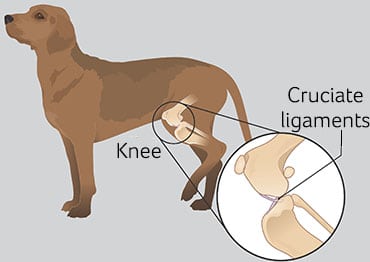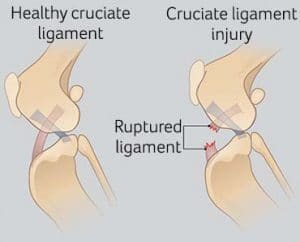Cranial Cruciate Injuries in Dogs
Are related to the knee joint (stifle joint) of the dogs that impart serious walking complications to dogs. The main reason for such injuries is the degeneration of the cruciate ligament supporting the stifle joint. It induces pain and ultimately lameness in dogs.
What is the function of the Cruciate ligament in dogs?
The function of cruciate ligament in dogs is similar to the function of anterior cruciate ligament of humans. The function of the Cranial Cruciate ligament is to support the knee joint in dogs. Knee joint is present in the thigh region of dogs that affixes the femur to the tibia. These are the bones whose articulation results in a stifle joint.
The main function of the Cruciate ligament in dogs is to prevent the over-extension and rotation of the stifle joint. In addition, it also supports the tibia and staves off its forward motion against the femur bone. That’s why a healthy Cruciate Ligament is necessary for dogs to have a safe and comfortable walk.
Cranial Cruciate ligament injury in dogs has a different origin compared to humans. Moreover, the progression of the disease is also different, which terms as degeneration of the ligament rather than trauma. On the other hand, the same condition in humans results from severe and sudden damage.
That’s why; the treatment of such conditions is quite different from that of humans.
What are the risk factors of developing Cranial Cruciate Injuries in dogs?
The major risk factor of the Cranial Cruciate injury is genetics. The consequence of which leads the ligament’s fibers to deteriorate. The deterioration in such a case is a slow but persistent process that causes the gradual weakening of the ligament. Moreover, certain breeds of dogs such as Labradors, West Highland White Terriers, Boxers, and Newfoundlands are more prone to such injuries.
Other contributory factors include hormonal imbalance, obesity, body conformation, overweight and inflammatory conditions.
How would I know that my dog is facing the Cranial Cruciate Ligament injury?
Ligament injury?
Certain signs and symptoms will help you out to know about the presence of the condition or not. First of all, the dog experiencing the cruciate ligament injury will show limping. It may occur during or after the session of exercise. This condition may occur off and on and results in difficulty getting up from the dog.
Moreover, here we have mentioned all the related signs and symptoms that indicate its presence.
- Reluctant to walk or jump
- Limping or lameness in the hind limb
- Reduction in muscle mass, especially around the thigh region
- Decreased activity level
- Difficult rise up after exercise
- The pain of varying severity
- Abnormal range of motion of the stifle joint
- Hesitation to play
- Swelling of the stifle joint
- Stiffness of the joint
In later stages, when the patient experiences the severity of the Cruciate ligament injury, there is evidence of pottery gait or lameness.
How does the Cranial Cruciate Ligament injury progress?
The occurrence of lameness in the affected dog results from a cascade of events that stimulate the fraying of the cruciate ligament. In this situation, the presence of osteoarthritis is a common and routine thing. All these factors lead to imposing painful lameness, which becomes a reason for uncomfortably.
Moreover, in later stages, mechanical lameness starts to prevail. One of the major reasons behind it is the sloppy structure of the tibia at its anterior end. It causes the femoral head to roll down over the inclined tibial end and thus imparts mechanical lameness.
One of the biggest problems that the slipping of the femur does is the injury to menisci cartilages. These menisci act as buffer cartilages that support the joint conformation and provide stability to the stifle joint. Tearing of these cartilages inflicts pain to the dog and exaggerates the lameness.
How to treat the Cruciate Ligament injury in dogs?
Just like the other skeletal degenerative diseases, the treatment plan of the cruciate I jury also involves two approaches. One of them is a non-surgical approach, while the other is surgical intervention.
1-Non-surgical approach
Non-surgical approach for the treatment of cruciate injury is a long-term treatment plan. It is only recommended for dogs that are not able to bear the surgical approach due to the presence of other diseases.
The major managemental approaches include physiotherapy, Hydrotherapy, anti-inflammatory medication, exercise modifications, and weight management.
2-Surgical approach
In surgery, the major purpose of achieving is the removal of the damaged portion of the ligament. In the next step, they replace it with the local tissue by using prosthetic ligament surgery.
It helps to regain the function of the stifle joint to a great extent and makes the dog enjoy a normal life.
Conclusion
Cranial Cruciate injuries are common in large breeds of dogs that are vulnerable to develop this degenerative disease. It is the leading cause of lameness and uncomforting in dogs. The positive point is that it is treatable and ensures the regaining of stifle joint functions.
References
https://www.acvs.org/small-animal/cranial-cruciate-ligament-disease
https://www.fitzpatrickreferrals.co.uk/orthopaedic/cranial-cruciate-ligament-injury/
https://www.vin.com/veterinarypartner/default.aspx?pid=19239&id=4952244



 Ligament injury?
Ligament injury?
